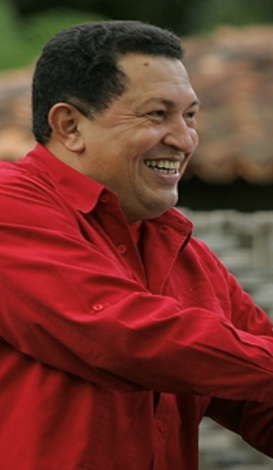In 2005, Mahmoud Ahmadinejad became President of Iran leading to closer ideological ties between Venezuela and Iran. President Ahmadinejad stated: “We want to create a bipolar world… Despite the will of the world arrogance [the U.S.], we will stand by the oppressed and deprived nations of the world.” This statement heralded an increasingly confrontational approach to the West, with the developing world serving as a platform for the Iranian regime’s anti-American rhetoric and policy. This messaging was well-received in parts of the Western Hemisphere, especially in Venezuela. Meanwhile, Ahmadinejad expanded Iran’s proxy war and destabilizing activities across the Middle East in an effort to undermine the U.S.-led regional security architecture and evict the U.S. military from the region.
A close personal bond also developed between Ahmadinejad and Chávez, both anti-American ideologues. Their friendship was evident in frequent state visits. Between 2005 and 2007, each leader made three visits to the other country. In July 2006, Chávez met Supreme Leader Ayatollah Khamenei in Tehran, and President Ahmadinejad awarded him Iran’s highest state honor, “the Higher Medal of the Islamic Republic of Iran.” Given Chávez’s support for Iran's nuclear program at the U.N. earlier in the year, this was not unexpected. On this visit, Chávez accused then-President George W. Bush of having a “relationship with the devil.”
Later in the year, Chávez welcomed Ahmadinejad to Venezuela and emphasized the revolutionary nature of their respective countries' regimes. He said, “Two revolutions are shaking hands: the Persian people, warriors of the Middle East…and the sons of Simón Bolívar, the warriors of the Caribbean, the free peoples.” Framing their respective revolutions this way, Chávez and Ahmadinejad sought to appeal to the desire to resist perceived U.S. domination and oppression. Chávez visited Tehran again in July 2007, meeting with his foreign minister and future president of Venezuela, Nicolás Maduro. Maduro was on the back leg of a trip to Lebanon, where he had met Hassan Nasrallah, the leader of the U.S.-designated terrorist organization Hezbollah. The summit offered the occasion for Chávez to declare that Iran and Venezuela constituted an “axis of unity” opposed to the U.S., and established closer ties between Venezuela and Iranian proxies like Hezbollah.
In March 2013, President Chávez died from cancer and was succeeded by his vice president, Nicolás Maduro. That month, Ahmadinejad declared he had “no doubt that he [Chávez] would be resurrected and return alongside Jesus Christ and Mahdi [the Hidden Imam] to establish peace and justice in the world.” These remarks were considered heretical by officials, clergy, and ordinary people in Iran, indicating Iran’s majority Shia population did not share the same enthusiasm for the Venezuelan socialist dictator. This situation highlighted the balancing act required for an Islamic theocracy to express sympathy for a socialist regime while maintaining its internal religious integrity. However, despite Iran’s status as an international pariah and its religious and political differences with Venezuela, the relationship has remained intact. A shared animosity towards the U.S. remains the defining characteristic of the partnership to this day.
